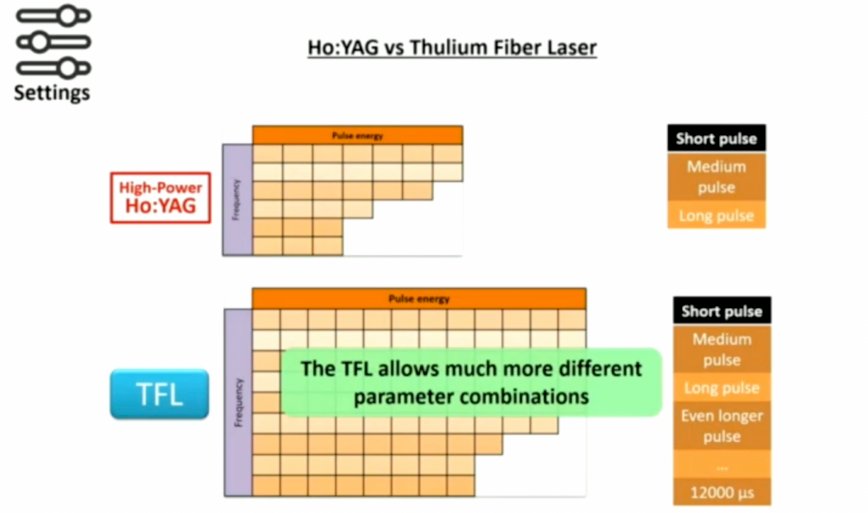(UroToday.com) The Saturday AUA afternoon plenary session continued with a lecture by Dr. Peter Kronenberg regarding the Thulium Fiber Laser (TFL) and its current role in Urology. Dr. Kronenberg began by outlining why the Holmium laser (Ho:YAG) was considered the gold standard by Urologists for the past 20-25 years. This included that fact that Holmium Laser is absorbed by water at a distance of only 0.4 mm rendering it safe for use in the ureter and collecting system, fragments and ablates any type of stone and lastly, cuts, coagulates, ablates and enucleates tissue. For many years, the Holmium laser has been considered the safest, most useful and most versatile lasers in all Urology.
However, with the introduction of the Thulium Fiber Laser in 2019 Dr. Kronenberg questions the role of Holmium laser in the current landscape and provides an update on the benefits of the thulium laser. The first points that were highlighted were the improved physical properties and technical specifications of the thulium laser. The Thulium laser has a much-increased depth of penetration in water of up to 0.77 mm compared to Holmium at 0.314 mm. Almost 100% of the energy from the thulium laser is absorbed within 0.314 mm with almost negligible energy dissipation at 1 mm compared to 4% of energy dissipated with the Holmium laser at 1 mm. The Thulium laser allows for much more versatile pulse energy settings with settings as low as 0.025J which can be ideal for dusting of stones. Additionally, the Thulium laser can achieve frequencies of up to 2400 Hz compared to only 120 Hz in the most modern Holmium Units.

Dr. Kronenberg reminds us about the early clinical benefits seen with the use of the Thulium Fiber laser including that TFL fragments twice as fast as Ho:YAG laser, TFL dusts 4 times faster than the Ho:YAG system and TFL allows for faster ablation of any stone type at any setting. However, do these benefits still hold in 2022? The most recent literature is reviewed which reveals that TFL is safe and a highly efficient laser. TFL demonstrates higher ablation efficacy and rates along with better stone free rates of 94.9% in PCNL compared to 90.9% with Ho:YAG.1,2 The results of a recent randomized clinical trial regarding TFL and URS showed a much superior stone free rate of 92% vs 67% in the Ho:YAG system.3
The other main benefits touted by the Thulium laser include the size and quality of the dust created by the TFL system. Recent studies have shown that the TFL system not only creates more quantity but also higher quality of dust with fragments smaller than 100 microns.4 An additional advantage is minimal to no retropulsion as evidenced by review of the most recent studies.3,5

The TFL system also allows for many more combinations of parameters for different situations including altering energy, and frequency and also modulating pulse width. This results in the ability to ablate or dust stones with optimal settings in various anatomic locations.

Besides the physical properties of the laser for ablation of all stone types the TFL system also has clinical benefits. Recent studies have revealed shorter operative times and faster ablation of stones.1,2 The other non-clinical benefits of the laser include a smaller, quieter machine that can be fit even into a standard endoscopic tower rack. The TFL system does not require a high energy power outlet which allows it to be used in any operating room without any specialized hardware and also consumes a significantly smaller amount of energy at 800W as compared to 10,000W of the Ho:YAG system.

Lastly Dr. Kronenberg outlines some of the concerns regarding Thulium Fiber laser with regard to super heating of irrigation fluid and risk of ureteral and collecting system injury. The recent clinical evidence suggests that there is no difference in increases in temperature with Thulium vs the Holmium laser and causes similar increases in temperature when used at comparable settings.6,7
Overall, the Thulium fiber laser is a safe, efficient laser that can be used to ablate all stone types and also tissue applications with appreciable benefits including faster more efficient stone ablation, shorter OR times, an easier to use system with a small footprint and should be considered the new gold standard for laser technology in Urology.
Presented By: Dr. Peter Kronenberg, MD, Hospital CUF Descobertas, Lisboa, Portugal.
Presenter Disclosures: Boston Scientific, EDAP, Lumenis, Olympus, Rocamed, Sun Pharma
Moderators: Dr. Hassan Razvi MD, FRCSC & Dr. Anthony Smith MD
Written By: Sohrab Naushad Ali MD, MSc, FRCSC Endourology Fellow, Department of Urology, University of California Irvine, @sohrabnaushad on Twitter during the 2022 American Urological Association (AUA) Annual Meeting, New Orleans, LA, Fri, May 13 – Mon, May 16, 2022.
References:1. Ulvik Ø, Æsøy MS, Juliebø-Jones P, et al: Thulium Fibre Laser versus Holmium:YAG for Ureteroscopic Lithotripsy: Outcomes from a Prospective Randomised Clinical Trial. Eur Urol 2022.
2. Mahajan AD and Mahajan SA: Thulium fiber laser versus holmium:yttrium aluminum garnet laser for stone lithotripsy during mini-percutaneous nephrolithotomy: A prospective randomized trial. Indian J Urol 38: 42–47.
3. Traxer O and Corrales M: Managing Urolithiasis with Thulium Fiber Laser: Updated Real-Life Results-A Systematic Review. J Clin Med 2021; 10.
4. Hardy LA, Vinnichenko V and Fried NM: High power holmium:YAG versus thulium fiber laser treatment of kidney stones in dusting mode: ablation rate and fragment size studies. Lasers Surg Med 2019; 51: 522–530.
5. Carrera R v, Randall JH, Garcia-Gil M, et al: Ureteroscopic Performance of High Power Super Pulse Thulium Fiber Laser for the Treatment of Urolithiasis: Results of the First Case Series in North America. Urology 2021; 153: 87–92.
6. Petzold R, Suarez-Ibarrola R and Miernik A: Temperature Assessment of a Novel Pulsed Thulium Solid-State Laser Compared with a Holmium:Yttrium-Aluminum-Garnet Laser. J Endourol 2021; 35: 853–859.
7. Taratkin M, Laukhtina E, Singla N, et al: Temperature changes during laser lithotripsy with Ho:YAG laser and novel Tm-fiber laser: a comparative in-vitro study. World J Urol 2020; 38: 3261–3266.


